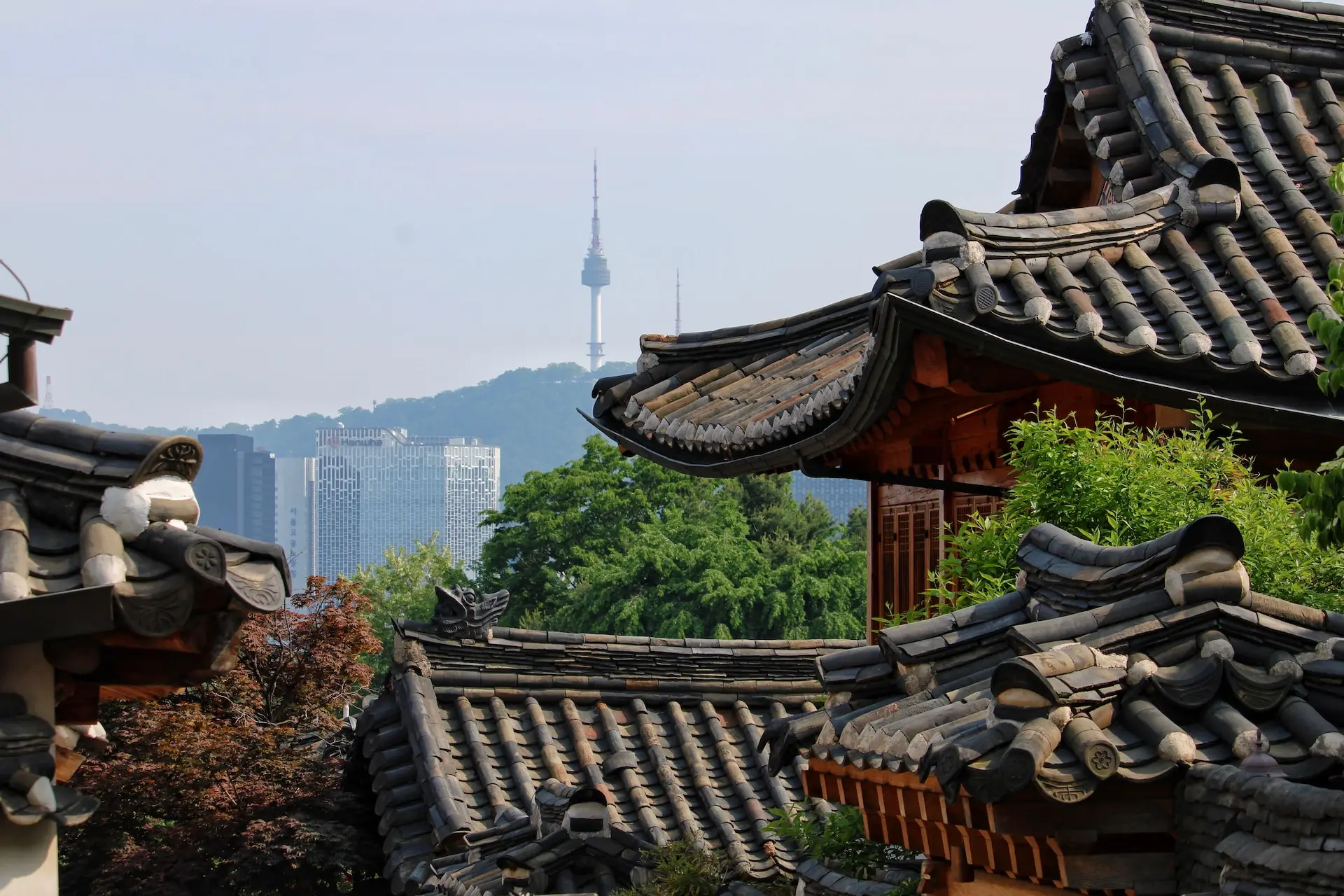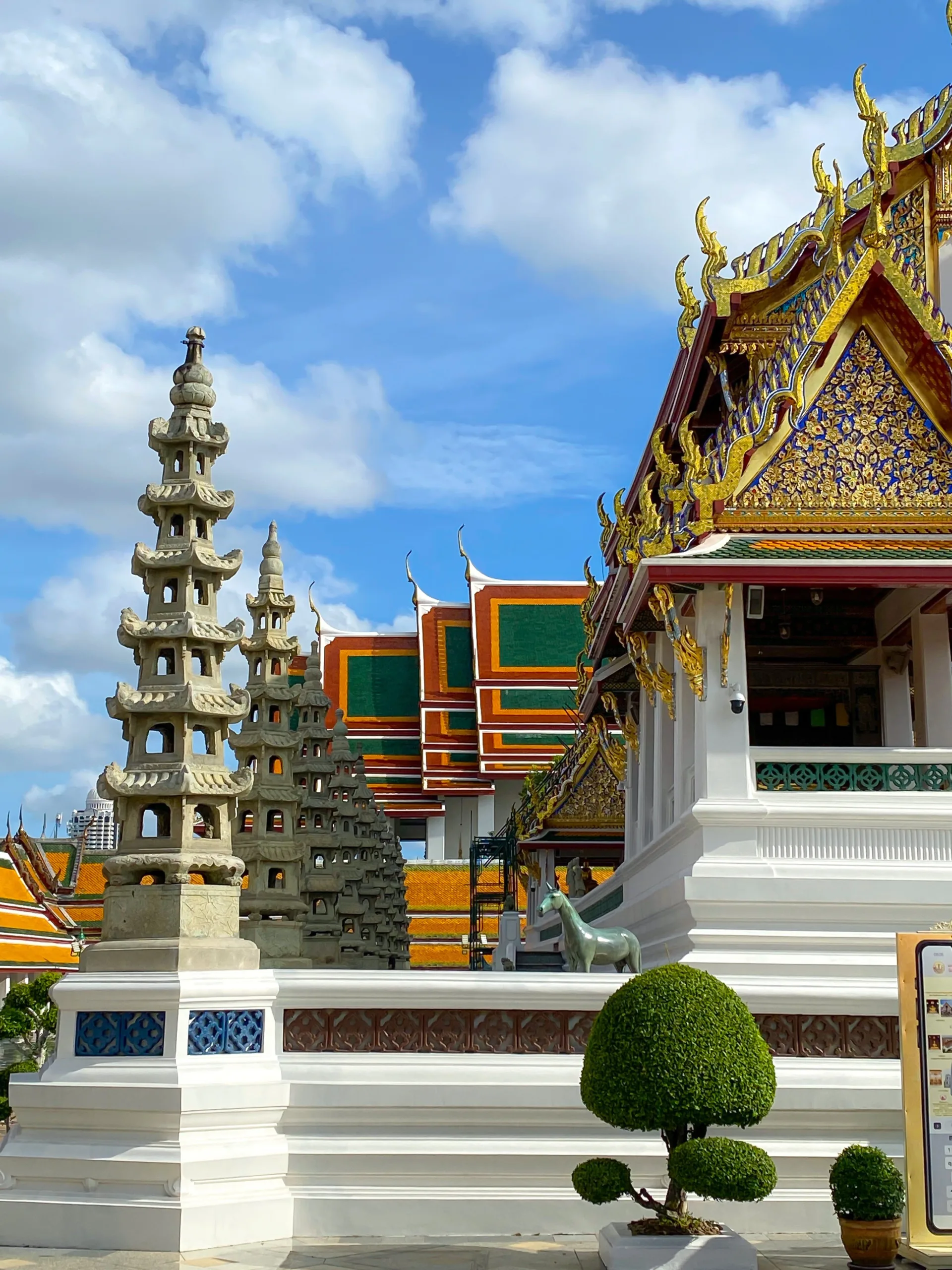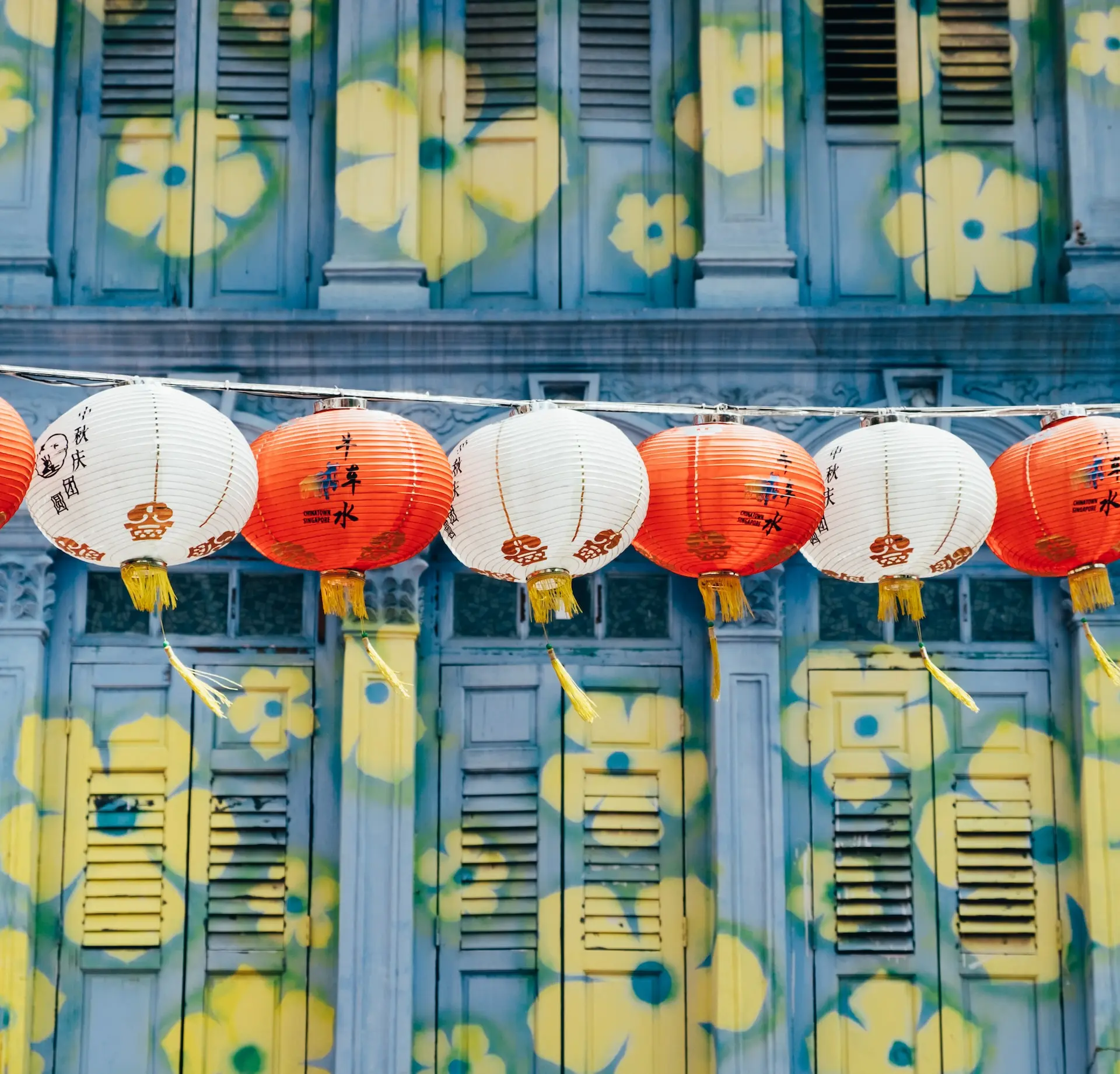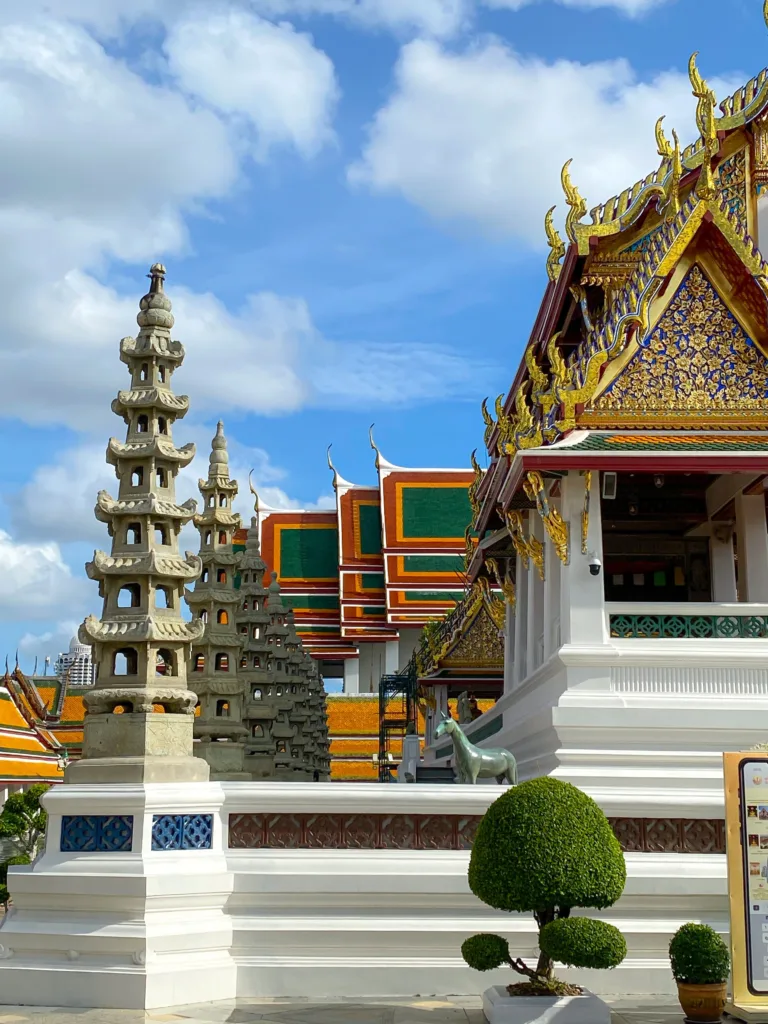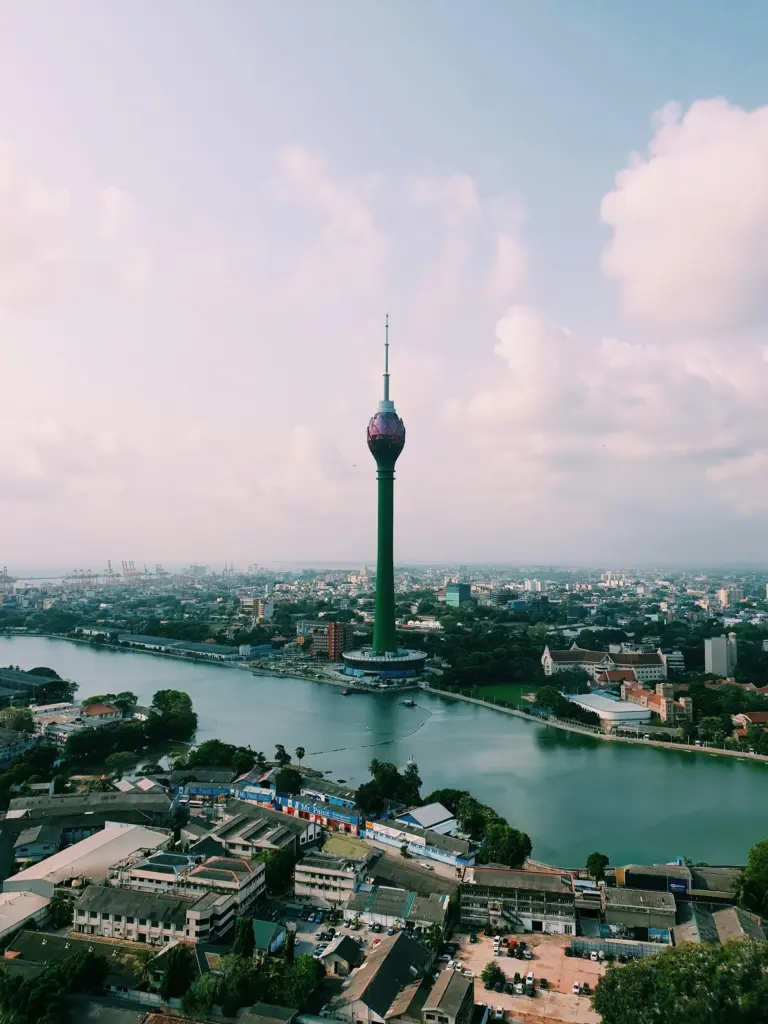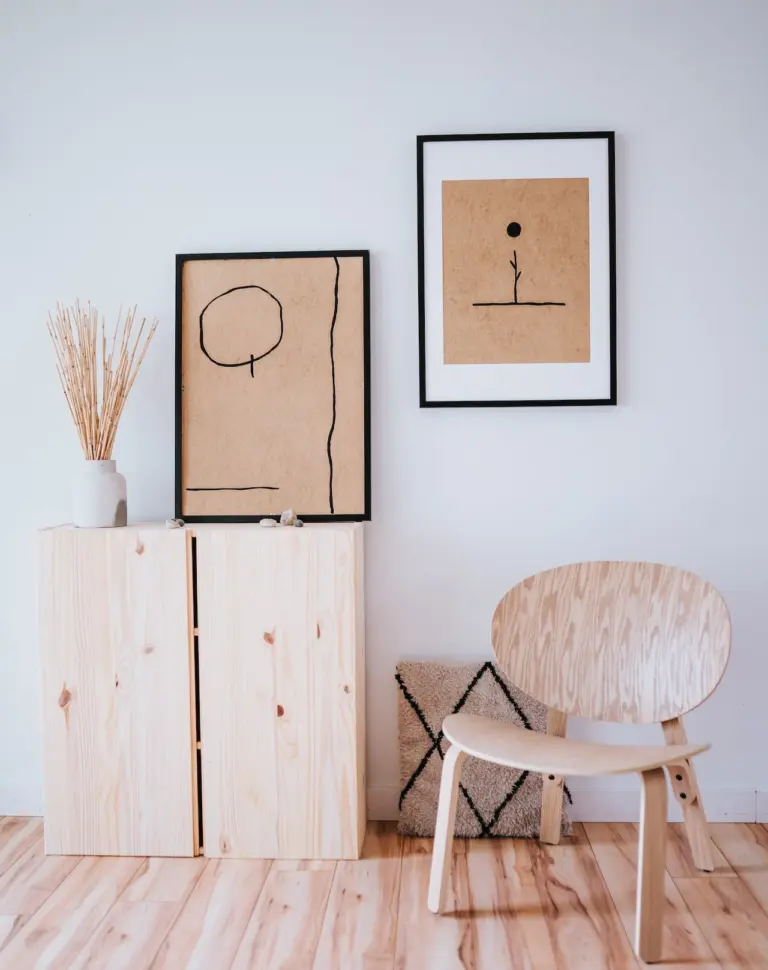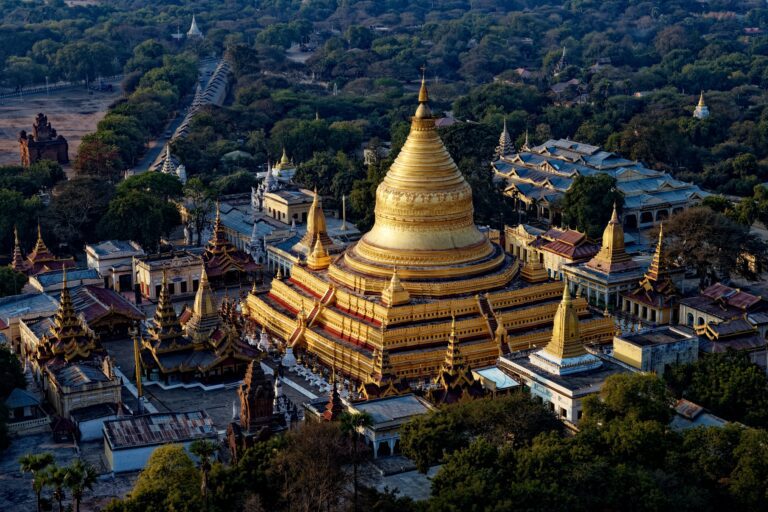Vientiane, the capital city of Laos, is a hidden gem that is often overlooked by travelers as they proceed on to other neighboring cities such as Vang Vieng. This charming city has a lot to offer, from its rich history to its bustling markets and delicious food. The laid-back atmosphere and friendly locals make Vientiane a great place to spend a few days to get a taste of what the country is like.
One of the first things I noticed while going around Vientiane is that it’s very easy get around. The city is compact, I was even able to see most of the spots simply by walking as most of the main attractions are within walking distance from each other, super convenient! The Mekong River, which flows through the heart of the city, offers a scenic backdrop for a stroll along the riverfront promenade. While I was doing Couchsurfing, my host spent a lot of afternoons just jogging by the Mekong. I really recommend to get a bit Zen and just sit down and watch the water flow as the sun sets in the horizon.
A city of contrasts, where ancient temples and colonial-era buildings coexist with modern high-rises and trendy cafes, you can easily get lost in awe as you go from one place to another. The city’s most famous landmark is the golden stupa of Pha That Luang, a sacred Buddhist site that’s been an important symbol of Lao culture for centuries.
Table of Contents
ToggleHistory of Vientiane
Vientiane has a rich and fascinating history that dates back to the 16th century. According to legend, the city was founded by a Khmer prince named Phra Nha Luang, who was seeking a new location for his capital after being forced to leave his former kingdom. As he wandered the countryside, he came upon a beautiful stretch of land along the Mekong River, and he knew he had found the perfect spot to build his new city.
Over the centuries, Vientiane has been ruled by various kingdoms and empires, including the Khmer, the Siamese, and the French. Each of these influences has left its mark on the city, from the ancient temples and stately colonial-era buildings to the bustling markets and trendy cafes that line the streets today.
Lao Culture Overview
Lao culture is deeply influenced by Theravada Buddhism, which has been the dominant religion in Laos for centuries. The Lao people are known for their friendly and welcoming nature. An important aspect of the culture is showing respect for elders while a sense of modesty is highly valued in society.
I have made a separate blog post that goes in-depth about Lao culture, customs, traditions, and festivals, if you are heading to Laos be sure to check it out as I’m sure it’ll come in handy!
Best Places to Visit in Vientiane
As mentioned above, Vientiane is compact and most of places are easily reachable via walking. Apart from Pha That Luang which is the furthest one in the group (but definitely still doable!). According to Google Maps, the whole walking route takes around 1 hour and 30 minutes, not including the time spent in each location. It may be wise to spread it to 2 days to have enough time to immerse and take in the unique vibe of each location but I hope the list can serve as a good reference for your own personal self-guided walking tour.
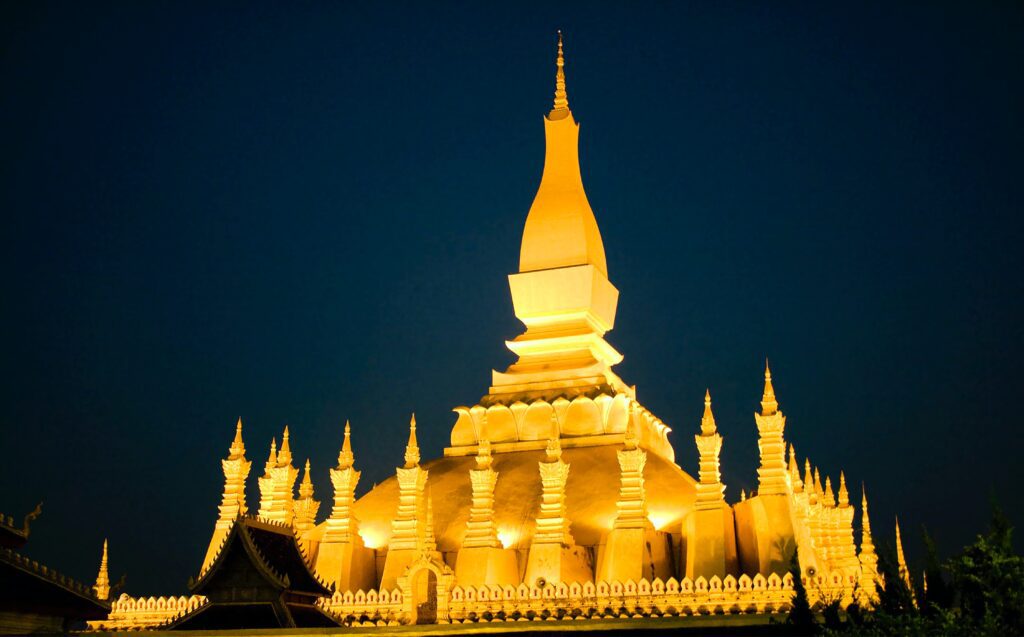
1. Pha That Luang
My Couchsurfing host at that time gave me a ride on her motorbike as we headed to Pha That Luang, the most famous landmark of Vientiane. It is an awe-inspiring golden stupa that towers over the cityscape. Its shimmering exterior reflects the sunlight, casting a warm glow that seems to draw you in from afar. Walking through the ornate gates of the temple complex, you can’t help but feel a sense of reverence and wonder with the sound of chanting and the scent of incense wafting through the air.
Legend has it that the original stupa at this site was built in the 3rd century BC, during the reign of the great Buddhist emperor Ashoka. Over the centuries, it was destroyed and rebuilt several times, with the current structure dating back to the 16th century. Today, Pha That Luang serves as an important symbol of Lao culture and national identity, as well as a place of pilgrimage for Buddhists from all over the world. It’s the enduring legacy of Buddhism in Laos.
Cost: 10,000 LAK / 1 USD
2. Cooperative Orthotic and Prosthetic Enterprise (COPE) Visitor Center
Not your typical tourist attraction, but it’s definitely worth a visit. The non-profit center was founded in 1997 to help provide prosthetic limbs and other mobility devices to those who have lost limbs due to accidents or war in Laos. The center has a museum that displays a range of prosthetic devices used in different parts of the world, from the earliest forms of prosthetics made from wood and leather to the modern, high-tech prosthetics. The museum also has a section that tells the stories of the people who have benefited from the services provided by COPE. Visiting the COPE Visitor Center can be a powerful and eye-opening experience that sheds light on a little-known aspect of Laos’ history and the ongoing efforts to help those affected by it.
Cost: Free, but donations are encouraged and greatly appreciated to support the cause of providing rehabilitation services to people with disabilities.
3. Wat Si Muang & Vientiane City Pillar Shrine
Wat Si Muang, known as the Mother Temple, is one of the most important and popular temples in Vientiane. Located near the city center, this temple is said to have been built on the spot where a young woman named Si Muang sacrificed herself to protect the city from disaster. Inside the temple, there is a large golden Buddha statue, as well as several other smaller statues and relics.
On the way, you can also pass by the Vientiane City Pillar Shrine. It is believed to protect the city and ensure its prosperity, and is said to contain the essence of the city’s spirit and the power of its guardian deities. The pillar is also seen as a link between the heavens and the earth, and is an important site for traditional ceremonies and festivals. Many locals and visitors come to pay their respects to the city pillar and offer prayers and offerings to the guardian spirits.
Cost: Free for both places, but donations are encouraged to help support the upkeep of the temples

4. Patuxai Victory Gate
Also known as the Patuxai Victory Monument or Victory Gate, Pa Tu Xai is a massive concrete arch on Lang Xang Avenue. A prominent landmark in Vientiane that represents the city’s struggle for independence. Built in the 1960s, the monument stands proudly as a symbol of Laos’ fight against colonization and imperialism. Ascend the stairs and you’ll be treated to breathtaking views of the city. From this vantage point, you can see the bustling streets and neighborhoods, the winding Mekong River, and the surrounding hills that give Vientiane its distinct landscape.
It’s also a gathering place for locals, who come here to relax, socialize, and enjoy the scenery. The atmosphere at Pa Tu Xai is lively and welcoming, I remember seeing families having picnics, couples taking romantic walks, and groups of friends playing games.
Cost: Free, but to go up it’s 3,000 LAK / 0.2 USD
5. Ho Phra Kaew
Just after a 10 minute walk from Wat Si Muang, you’ll arrive in Ho Phra Kaew. The temple’s architecture is a beautiful blend of Lao and Thai styles, with a unique, ornate roof made of multiple tiers and adorned with intricate wood carvings and gold leaves. It was originally built in 1565 as the royal temple of the Lao monarchy to house the Emerald Buddha, which was brought to Laos from Thailand. The temple was used to hold important religious and state ceremonies and was considered the most important temple in the country.
During the Siamese occupation of Laos in the late 1700s, the Emerald Buddha was taken to Bangkok, and the temple was converted into a museum to house the many religious artifacts and treasures that had been collected over the centuries.
Cost: 30,0000 LAK (1.75 USD)
6. Wat Si Saket
Located in the heart of Vientiane, Wat Si Saket is a magnificent Buddhist temple and one of the city’s most significant landmarks. Built in the early 19th century, the temple also features a unique blend of Lao and Thai architectural styles, and is particularly renowned for its thousands of Buddhas all around its halls.
The temple was built during the reign of King Anouvong, the last king of the Lan Xang Kingdom, and is believed to have been spared from destruction during the Siamese invasion of 1828 due to its Thai-inspired design.
Cost: 5,000 LAK (0.5 USD)
7. That Dam
Just 450 meters away from Wat Si Saket lies That Dam, the Black Stupa. It is believed to have been built during the 16th century as a symbol of the Lao Kingdom’s independence from Siam. The stupa is said to have once been covered in gold, but over time the gold was removed and the stupa was painted black.
According to local legends, there was once a seven-headed naga (serpent-like being prominent in Buddhist and Hindu lore) who lived in the area and terrorized the local villagers. The naga was eventually defeated by a local hero, slain with a magical sword. The sword was then used to build That Dam as a protective shrine to ward off any future attacks by the naga.
Cost: Free
8. Chao Anouvong Park & Vientiane Night Market
End your day at Chao Anouvong Park, named after the very same king who built Wat Si Saket. It features a large statue of King Chao Anouvong right at the center. Here you can relax and watch the sunset beside the Mekong River. At night, watch it come alive as both locals and tourists flock to the nearby Night Market.
Cost: Free
Hidden Gems in Vientiane

9. Xieng Khouane (Buddha Park)
While not technically in Vientiane, it’s relatively easy to get to and very much worth the 1-hour journey. Located just 25 kilometers southeast of Vientiane, this park is home to a huge collection of Buddhist and Hindu sculptures, many of which are larger than life and intricately carved. You will find Buddhas of all shapes and sizes from reclining, sitting, standing and even abstract forms such as a multi-faced head with arms all around! It’s something akin to a fusion of a religious site and an open-air museum.
While there are plenty of choices available such as taxis and tuk-tuks, the public bus is the best choice in terms of cost. Look for Bus #14 at Talat Sao Bus station departing every 15-20 minutes. Take the same bus at the opposite side of the street to get back to town.
Cost: Bus ride for 8,000 LAK (0.5 USD); Entrance fee 15,000 LAK (1 USD)
10. National Lao Museum
The National Lao Museum is a hidden gem that is usually overlooked as it lies further from the main sights around the city center. Just a bit further than Pha That Luang, this museum is home to an impressive collection of artifacts and exhibits that showcase a wide range of topics, including prehistoric artifacts, traditional Lao costumes and textiles, ancient religious objects, and much more
The museum is housed in a beautiful French colonial building, which was originally built as a governor’s residence in the early 20th century and was later converted into a museum in 2007.
Cost: 10,000 LAK (1 USD)
11. Wat That Khao
A quaint and peaceful temple still within Vientiane, Wat That Khao offers you the chance to see a giant golden seated Buddha as well as a large golden reclining Buddha. You will most likely be the only visitors here as it isn’t the most popular temple but it offers something unique to those.
Cost: Free
12. Wat Ong Teu Mahawihan
If you still aren’t tired from all the temple hopping, here’s another temple with a history dating back to the early 16th century. Wat Ong Teu Mahawihan, also known as “the Temple of the Heavy Buddha” due to the large bronze Buddha statue that resides within. It is the highlight of the temple and it weighs in at over 5 tons! It is just a short walk from Chao Anouvong Park so if you have the time, why not try visiting this temple?
Cost: Free, but donations are encouraged to help support the upkeep of the temple
Top Things to Do in Vientiane
13. Get a Traditional Lao Massage
If you’re looking to unwind and experience something truly unique during your travels, be sure to give Lao massage a try. A traditional form of massage that has been passed down for generations, and is rooted in the country’s Buddhist culture.
Similar to Thai massage, Lao massage focuses on applying pressure to specific points in the body, using hands, elbows, and even feet to help release tension and improve circulation. The massage itself is typically done on a mat on the floor, and involves gentle stretching and deep tissue work to help relax and rejuvenate the body. Your body (and mind) will thank you!

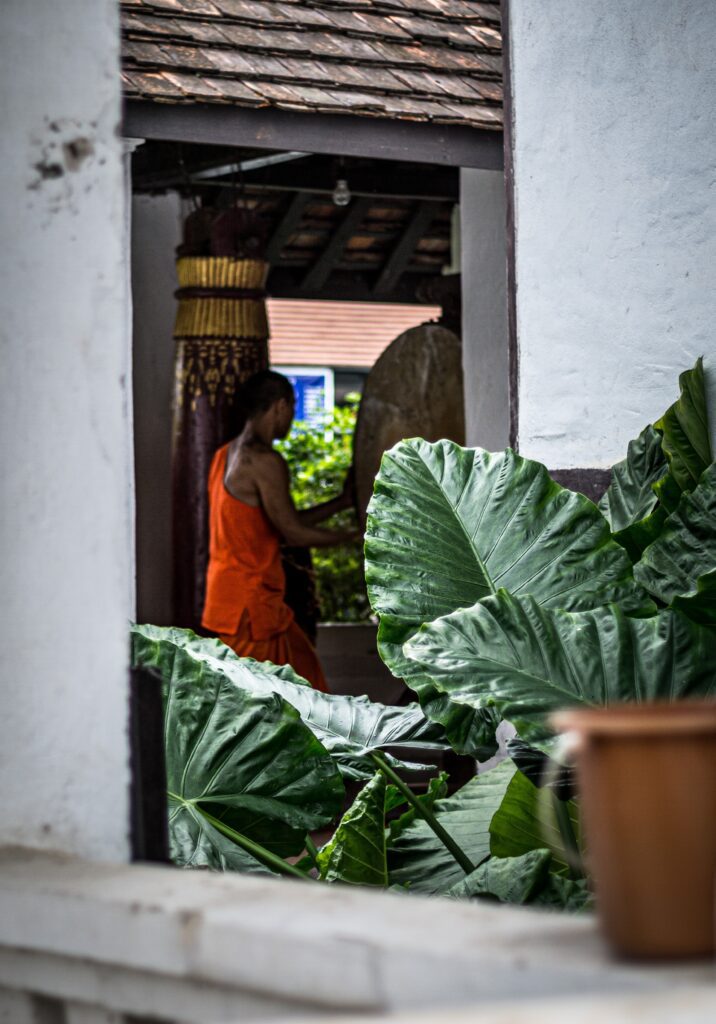
14. Meditate with Monks
For an enlightening and peaceful experience, consider visiting Wat Sok Pa Luang. Led by the resident monks, this serene temple offers guided meditation sessions for anyone interested to get in touch with their inner selves. You’ll be able to join the monks in their daily meditation session, and learn about the techniques and philosophies behind their practice. The session lasts about an hour and is conducted in English, making it accessible for all levels of experience. Not only will you gain a deeper understanding of the Buddhist culture and traditions of Laos, but you’ll also leave feeling more centered, calm, and connected to yourself and the world around you.
15. Cycle around Vientiane
Why not rent a bike and explore the city at your own pace? You can rent a bike from many shops in the city and make your way to the riverfront where you can cycle along the Mekong River. It’s a great way to see Vientiane from a different perspective and get some exercise at the same time! You catch a glimpse into the daily lives of the people while stopping by for a break at one of the many cafes by the river. The best time to cycle along the Mekong River is during the early morning or late afternoon when the weather is cooler and the sun is not too harsh. The views of the sunset over the river are especially breathtaking and not to be missed!
16. Take a Lao Cooking Class
One of the best ways to get a taste of a country’s culture is through its cuisine, and what better way to do that than by taking a cooking class? Vientiane offers a variety of cooking classes where you can learn to cook traditional Lao dishes such as laap, tam mak hoong, and sticky rice. Cooking classes are usually led by experienced Lao chefs who will guide you through the cooking process and share their knowledge about Lao culture and food.
17. Watch a Traditional Lao Dance Performance
Watching a traditional Lao dance performance is a must-do activity while in Vientiane. Lao dance is deeply rooted in Buddhist and Hindu traditions and includes graceful movements and intricate costumes.
One great place to see a traditional Lao dance performance is at the Lao National Cultural Hall. The hall hosts performances on select evenings throughout the year, showcasing different styles of Lao dance.

18. Peruse the Local Market
Talat Sao in Lao, is a bustling market where locals and tourists alike can check out a wide variety of goods. The market is open every day from early morning until late at night, but it’s best to visit in the morning when the market is at its busiest and most vibrant.
You can find everything from traditional Lao textiles and handicrafts to electronics and fashion items. The market is also a great place to sample local street food and snacks. Be prepared to haggle and don’t forget to bring cash, as many vendors don’t accept credit cards!
Where to Stay in Vientiane
Vientiane has numerous hotels and hostels that cater to all sorts of travelers, these are the ones I recommend:
Best Hotels in Vientiane
- Chanthapanya Hotel – comfortable and convenient accommodation option, offering free WiFi, an outdoor pool, and a sauna. With free private parking available on site.
- Eastin Hotel – offers modern and stylish accommodation with an outdoor swimming pool, fitness center, and garden. You can also enjoy a restaurant, bar, and buffet breakfast. Convenient amenities like free private parking and in-room fridges also make for a comfortable stay.
- Muong Thanh Hotel – five-star accommodation with a seasonal outdoor pool, tennis courts, and a spa. The hotel features modern guestrooms with individual air conditioning, complimentary in-room WiFi, and satellite TV. You can also enjoy a variety of dining options and relaxing amenities like the Lotus Spa and Massage, fitness center, and Karaoke rooms.
Best Hostels in Vientiane
- Nana Backpacker Hostel – features a garden, bar, and river views. With free WiFi, the hostel is located within walking distance of popular attractions like Laos National Museum and Wat Sisaket.
- Sailomyen Hostel – offers a loft design accommodation with an in-house cafe on the ground floor. Located just a 5-minute drive from Talad Sao and Mekong River, the hostel provides clean and comfortable rooms with free Wi-Fi, seating areas, and en suite bathrooms. The hostel is conveniently located within walking distance of popular landmarks.
- Ali Local Home – with air-conditioned rooms and a shared lounge. The hostel also provides a shared kitchen and free Wi-Fi. Rooms come with a desk and bed linen and towels are provided.
How to Get Around Vientiane
- Walking: Vientiane is a relatively small city, and many of the main attractions are located within walking distance of each other.
- Cycling: Many guesthouses and hotels offer bicycle rentals, and there are also several bike rental shops in the city. A great alternative to walking!
- Tuk-tuk: Tuk-tuks are convenient and inexpensive, and you can usually negotiate the fare with the driver. Just be sure to agree on the price before getting in to avoid any surprises at the end of the ride.
- Taxi: Taxis are also available in Vientiane, but they can be more expensive than tuk-tuks. You can also use ride hailing apps like Loca.
How to Stay Safe in Vientiane
Vientiane is a generally safe place to visit, I never once felt unsafe even while walking alone at night. There’s always the occasional pickpocket story but just keep your wits about you and everything should be alright. Be careful with tap water and street food if your tummy is sensitive!
That being said, it’s always better to be safe than sorry and I recommend getting travel insurance before setting out on your trip. SafetyWing is my go-to travel insurance company that wholeheartedly supports the nomadic lifestyle, you can find their website here.
Best Time to Visit Vientiane
The dry season (November to April) is considered the peak tourist season, with cooler temperatures around 15-25°C (59-77°F) and lower humidity levels making it more comfortable to explore the city’s sights and outdoor activities. This is also a great time to visit the many festivals that take place in Vientiane, such as the Lao New Year in April and the That Luang Festival in November.
The wet season (May to October), on the other hand, brings heavy rain and higher humidity levels with temperatures ranging from 25-30°C (77-86°F). While this may deter some tourists, it can be a great time to visit for those looking for lower prices and fewer crowds. The rain also helps to keep the city green and lush, making it a beautiful time to explore the countryside.
Plan Your Trip to Vientiane | Best Travel Resources
Book Your Accommodations
- Booking.com – the world’s leading online booking platform for accomodations around the world, they have an extensive amount of available listings with zero booking fees and best price guarantees.
- Hostelworld – a backpacker’s best friend, Hostelworld has the largest collection of hostels and guesthouses for affordable prices.
Don’t Forget Insurance
- SafetyWing – from Nomad Insurance, an insurance by nomads for nomads. They understand our lifestyle well and have really comprehensive and flexible plans that cater to any traveler.
Find Cheap Flights
- Kiwi.com – my go-to for booking and finding the cheapest flights and it’s helped me save tons of money. They do virtual interlining which is connecting flights from airlines that do not codeshare, so you can find routes that you wouldn’t be able to find normally.
Join Tours & Activities
- GetYourGuide – is one of the best places to find unique tours and activities. I found that it’s an excellent way to meet fellow travelers and create fond memories. They are not only limited to tours as they also offer niche services such as skip-the-line tickets or private transfers.
Catch a Ride
- Rentalcars.com – nothing beats the freedom of the road, Rentalcars.com is the world’s largest online car rental service. They operate across 160 countries so they’re the perfect partner to work with if you find yourself wanting a ride.

